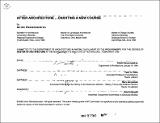After architecture : charting a new course
Author(s)
Ramachandran, Girish, 1963-
DownloadFull printable version (14.63Mb)
Other Contributors
Massachusetts Institute of Technology. Dept. of Architecture.
Advisor
Peter A. Testa, Mark Jarzombek.This evolutionary modeling tool keeps the clay wet for the architect to interact, interpret and translate these complex 3-D forms and spaces to architecture at any given time. It also provides the capability to track ancestral history of forms and to use genetic properties of any particular generation in the evolution process. The thesis thus sets the framework for future exploration based on artificial life, a new form of designed artifact interacting and evolving in harmony with natural forces.
Terms of use
Metadata
Show full item recordAbstract
The thesis is a synthesis of technology, art, science, computation and philosophy in charting a new course for architecture. It attempts to address the questions: Can architecture model natural phenomena's or nonlinear processes? Can we have a theory for the generation of architectural forms? The site becomes an impetus for wider search which parallels emerging scientific & nonlinear paradigms, resulting in a nonlinear thesis the final product of which is not inevitable. The site becomes the model of thinking and testing. The thesis addresses the importance for architecture to recognize the convergence of two most powerful disciplines i.e. Biology and Information technology, that would have a major impact on humanity and bio-sphere in the next millennium. It is an attempt to find new forms of inspiration from nature, to find a theory of generation of forms at a period when as a result of the technological advancements in genetic engineering, biotechnology, computation, information technology and molecular engineering (nanotechnology), the relationship between man and nature is getting blurred. Ideas and concepts of artificial life, genetics and biological analogies are proving to be very valuable in the advancement of computational techniques (genetic algorithms, genetic programs) and material sciences (bio-materials, nano-technology, memory shaped alloys). This thesis explores the potentiality for architecture to engage and embrace the emerging paradigms shifts in science and interpret them architecturally and to find ways in which architecture could interface at this convergence of Biology and Information technology. This challenge demands creative exploration at the levels of architectural theory, design strategy or concepts, methods and realization. The final product is a process that is based on biological analogies and genetics, coupled with emerging computational techniques of genetic programming as a generating force for architecture. The primary inspiration comes from the fundamental basis of genetics and evolution and the information systems of nature. A prototype system built as part of this thesis integrates evolution, both as a metaphor and an active generative modeling tool, with the interpretive aspects of the design process. The architect is firmly in control but the evolution module aids him or her by providing the unexpected 3-D spatial and volumetric configurations which would be impossible to conceive otherwise and suggesting novel combinations or adaptations of forms currently under consideration.
Description
Thesis (M. Arch.)--Massachusetts Institute of Technology, Dept. of Architecture, 1998. Includes bibliographical references (p. 96-107).
Date issued
1998Department
Massachusetts Institute of Technology. Department of ArchitecturePublisher
Massachusetts Institute of Technology
Keywords
Architecture.